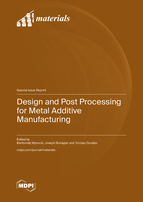Design and Post Processing for Metal Additive Manufacturing
A special issue of Materials (ISSN 1996-1944). This special issue belongs to the section "Manufacturing Processes and Systems".
Deadline for manuscript submissions: closed (10 October 2023) | Viewed by 28332
Special Issue Editors
Interests: additive manufacturing; titanium alloys; chemical polishing; cellular structures; implants; bioengineering; AI/ML
Special Issues, Collections and Topics in MDPI journals
Interests: additive manufacturing; surface engineering; biomaterials; medical implants; corrosion science; biodegradable metals
Interests: additive manufacturing (FDM, HT-FDM, SLA, SLM, LENS); titanium hip implants; superalloys, functional graded materials and composites; powder metallurgy; CNC machining
Special Issue Information
Dear Colleagues,
Additive manufacturing (AM) of metals has been receiving particular attention because functional, net shape parts in various industrial sectors can now be fabricated using laser, electron beam or binder jetting methods. Furthermore, recent advances in additive manufacturing (AM) techniques offer many opportunities in terms of design freedom. Complex geometries like cellular solids, metamaterials or biomimetic materials that could not be easily manufactured using conventional techniques are now relatively easy to be manufactured using AM. Today, these objects can be fabricated from elemental or alloyed metallic powders, based on the computer-aided design (CAD) models. This Special Issue is open to submissions concerning, but not limited to, design of elements with predicted microstructure and mechanical properties, artificial intelligence/machine learning (AI/ML) in AM, numerical algorithms for AM and µ-CT imagining for quality control. Despite the fact that AM manufacturing in a powder bed provides a possibility to fabricate objects of any shape in one production step, it also carries some disadvantages. One drawback is the requirement to generate support for the fabricated parts. Such support should dissipate the heat generated during 3D printing process from metallic powders and minimize geometrical distortions induced by internal stresses. The computer simulations and improved fabrication protocols that decrease these issues will be covered in this Special Issue. During the AM processes, not all particles are melted and, therefore, the removal of any unmelted particles needs to be performed with mechanical or chemical post-processing methods. This Special Issue is, therefore, dedicated to the various areas of research relevant to metal AM. The processing parameters and post-processing methods not limited to annealing and chemical modifications are of interest. Finally, the design of materials dedicated to metal AM and description of modifications to commercial machines are also welcome in the submissions.
Dr. Bartłomiej Wysocki
Prof. Joseph Buhagiar
Dr. Tomasz Durejko
Guest Editors
Manuscript Submission Information
Manuscripts should be submitted online at www.mdpi.com by registering and logging in to this website. Once you are registered, click here to go to the submission form. Manuscripts can be submitted until the deadline. All submissions that pass pre-check are peer-reviewed. Accepted papers will be published continuously in the journal (as soon as accepted) and will be listed together on the special issue website. Research articles, review articles as well as short communications are invited. For planned papers, a title and short abstract (about 100 words) can be sent to the Editorial Office for announcement on this website.
Submitted manuscripts should not have been published previously, nor be under consideration for publication elsewhere (except conference proceedings papers). All manuscripts are thoroughly refereed through a single-blind peer-review process. A guide for authors and other relevant information for submission of manuscripts is available on the Instructions for Authors page. Materials is an international peer-reviewed open access semimonthly journal published by MDPI.
Please visit the Instructions for Authors page before submitting a manuscript. The Article Processing Charge (APC) for publication in this open access journal is 2600 CHF (Swiss Francs). Submitted papers should be well formatted and use good English. Authors may use MDPI's English editing service prior to publication or during author revisions.
Keywords
- additive manufacturing / 3D printing
- powder bed fusion (PBF)
- laser metal deposition (LMD)
- design approaches and process simulations
- am post-processing
- new materials, metal additive manufacturing processes and systems
- artificial intelligence and machine learning (AI/ML) in AM
- standardization and quality control in metal additive manufacturing









